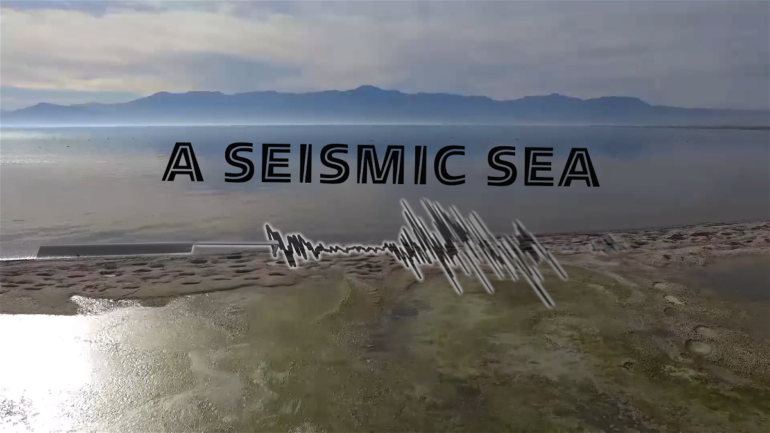The southern end of the San Andreas Fault that runs directly below the Salton Sea in Southern California currently poses the largest seismic hazard in the state, but the area hasn’t experienced a major earthquake in more than 300 years.
Now, a new study in the journal Nature by scientists at San Diego State University in collaboration with UC San Diego’s Scripps Institution of Oceanography has found that as the Salton Sea has dried up, it has eased the strain on this part of the fault, potentially postponing a quake that could devastate Los Angeles.
SDSU NewsCenter’s Susanne Clara Bard asked geophysicist graduate student Ryley Hill and his advisor and co-author Matthew Weingarten about what this means for future earthquakes in the region.
The Salton Sea, which is a remnant of the much larger ancient Lake Cahuilla, has gone through many cycles of drying out and filling up again due to fluctuations in the climate. Your study found that over the past thousand years major earthquakes took place every time water levels in the lake reached a high point, about every 180 years. Why is that?
Hill: Ancient Lake Cahuilla held approximately 40 times the volume of water as today’s Salton Sea, with an area six times the size. The lake filled and dried up periodically over the past 1,000 years. When the lake would fill, it was large enough to bend the upper crust of the Earth. This is like taking a ruler and bending it in the middle, unclamping the two sides of the fault and causing it to slip.
Another effect is the fluid of the lake itself. This causes an increase in pore pressure which also makes it easier for the fault to slip. A puck on an air hockey table is a good analogy. The increasing pore pressure from the fluid is like turning the air on—it pushes out on the two sides of the fault making it easier to slide, thus triggering an earthquake.
The Salton Sea has experienced a relatively dry period since the 1730s—300 years ago. Los Angeles to the northwest has experienced plenty of destructive earthquakes originating in the Southern San Andreas Fault since then, but none of these has topped magnitude 7.0 on the Richter scale. Does this drying period explain why?
Hill: The drying of the last lake contributes, in small part, to clamping the fault. However, this does not fully explain why we have not had a major earthquake during this time. We have direct geodetic measurements on this section of the San Andreas Fault. Regardless of any of the minor clamping effects the drying up of the last lake has had, the accumulation of stress from the tectonic plate motion has built up considerably over the past 300 years and will need to be released. If all that stress is released at once the fault has the current potential for a major (magnitude 7.0+) earthquake.
So we’re still overdue for the ‘Big One’?
Weingarten: Yes. Plate tectonics is operating on faults all over the world every day. We know from earthquake physics that the longer you go without relieving the stress built up on a fault, the more likely you are to have a major earthquake. That theory holds true for the Southern San Andreas, which poses the highest seismic hazard in the state.
The U.S. Geological Survey estimates the Southern San Andreas has a roughly three times greater chance than the Northern San Andreas of hosting a magnitude M7.5+ earthquake in the next 30 years (17.3% vs. 5.7%, respectively). The Northern San Andreas hosted the Great 1906 San Francisco Earthquake with an estimated magnitude of M7.9.
Hill: However, we can not determine for certain if all of the accumulated stress will be released at once in a large event (worst-case scenario) or if the stress will be released by a series of a few smaller earthquakes (best-case scenario).
How would San Diego likely be affected by a major earthquake in the Southern San Andreas if/when it occurs?
Hill: Thankfully, San Diego is in a fortunate position with regard to a large earthquake on the Southern San Andreas Fault. Shaking would be felt, but not as severe as other areas like LA. However, the Rose Canyon fault, which runs directly under San Diego, is capable of a magnitude 6.7–7.0 earthquake. It recurs about every 700–800 years, the last time in the mid-1700s. This fault poses the largest hazard for San Diego in large part due to its location.
What is your team investigating next?
Weingarten: We’re interested in all fluid-fault interactions occurring within Earth’s crust. Ultimately, our goal is to better understand the physics of earthquakes—both natural, like those on the San Andreas, and human-induced, like those in Oklahoma and other oil and gas-producing states.
Hill: There were three magnitude 5.0+ earthquakes in central Oklahoma in 2016 related to the disposal of fracking wastewater into the Earth. These earthquakes have caused significant structural damage. The goal is to better understand how to mitigate the seismic hazard that humans cause during the injection of wastewater. Similar to the work on the San Andreas, we build physics-based models to understand the stress and pore pressure inside the Earth.
More information:
L. Astete Vasquez et al, Effect of modified waste introduction methods over short-term and long-term use of onsite sanitation systems, Scientific Reports (2023). DOI: 10.1038/s41598-023-35110-x
Provided by
San Diego State University
Citation:
Q&A: Drying of the Salton Sea has staved off earthquakes, for now (2023, July 25)
